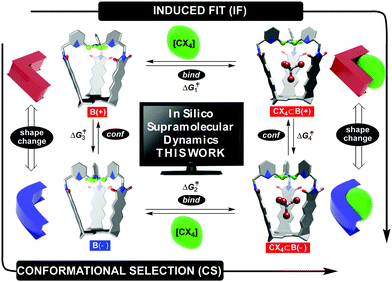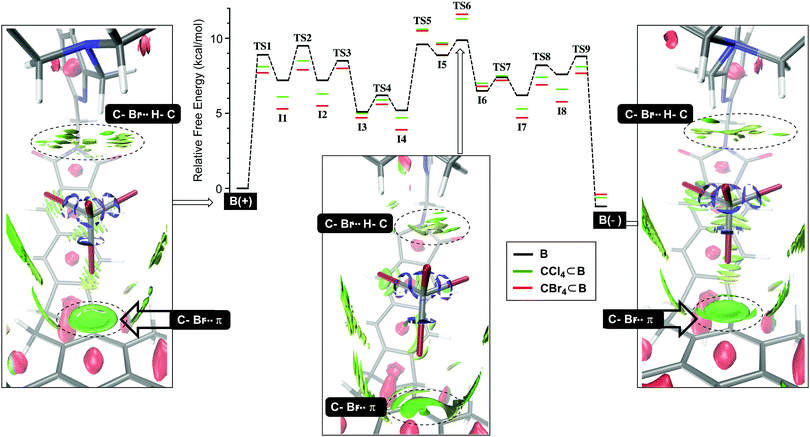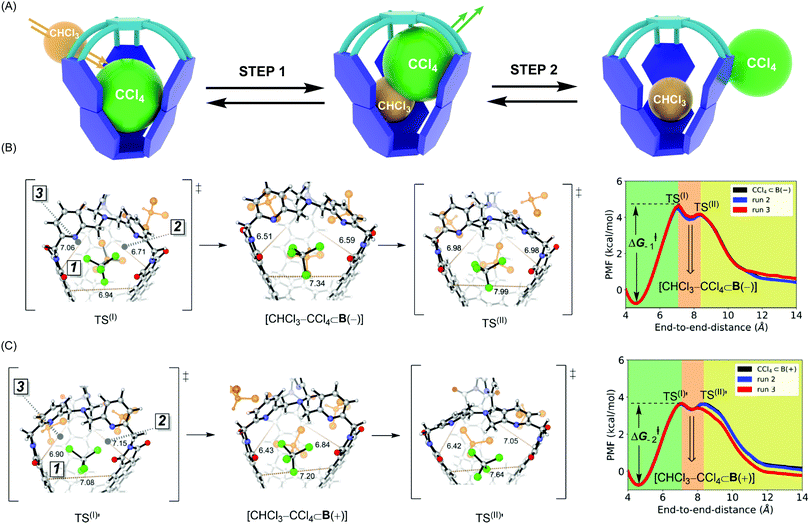A computational study of competing conformational selection and induced fit in an abiotic system†
Remy F.
Lalisse
,
Radoslav Z.
Pavlović
,
Christopher M.
Hadad
 * and
Jovica D.
Badjić
* and
Jovica D.
Badjić
 *
*
Department of Chemistry & Biochemistry, The Ohio State University, 100 West 18th Avenue, Columbus, OH 43210, USA. E-mail: hadad.1@osu.edu; badjic.1@osu.edu
First published on 6th December 2021
Abstract
Host–guest complexations can be described by two competing mechanisms, conformational selection (CS) and induced fit (IF). In this work, we used a combination of nudged elastic band (NEB), adaptive steered molecular dynamics (ASMD), and density functional theory (DFT, with a correction for dispersion) to study the dynamics of the pathways (IF/CS) by which two conformers of basket B(+) and B(−) interconvert and trap CX4 guests (X = Cl and Br). While the results from NEB/DFT studies disclosed host–guest noncovalent contacts reducing the basket's conformational dynamics, ASMD methodology suggested an associative mechanism for the guest complexation. With theory in excellent agreement with experiments, NEB and ASMD emerge as the methods of choice for studying dynamics of supramolecular systems.
Introduction
Fundamental studies of molecular recognition1 are essential for deciphering complex biological processes and their regulatory features in addition to designing supramolecular assemblies capable of performing increasingly demanding tasks.2 For instance, it is well recognized that the binding of ligands to natural receptors (bind step in Fig. 1) is coupled with conformational adjustment(s) (conf step in Fig. 1).3 The two processes constitute a critical part of allostery4 to enable the emergence of complex natural systems with intriguing mechanisms of action.5 Importantly, the chronological order of bind and conf steps gives rise to two mechanistic alternatives by which the recognition takes place (Fig. 1).6 For conformational selection (CS), a receptor exists as an ensemble of interconvertible conformers from which the optimal one gets selected for binding to a ligand (conf→bind, Fig. 1). Induced fit (IF) encompasses a non-optimal conformer of the receptor associating with the ligand first, followed by a reshaping of the receptor to complement the guest (bind→conf, Fig. 1). Indeed, deciphering the order of bind and conf steps requires a structural characterization of all of the conformational states involved, including determination of rate coefficients corresponding to their interconversion.7 In addition to elaborate biological molecules, the interplay of CS and IF has, in recent years, also been probed with supramolecular systems.8 We recently found9 that two conformers of basket B(+) and B(−) (each with the top twisted to the right or left, Fig. 1) would trap a molecule of tetrahalomethane (CCl4 or CBr4) to give CX4⊂B(+) and CX4⊂B(−).10 After the kinetics of the four-state equilibrium was elucidated, we used a flux-based analysis7 to reveal relative proportions of CS and IF pathways. Both mechanistic alternatives can occur simultaneously over a range of experimental conditions – lower concentrations of guests favoring CS, while higher concentrations favor IF. We wondered: would a computational study of our system's dynamics11 provide further mechanistic insight about the four processes? Why is the conformational interconversion of baskets (conf steps in Fig. 1) slowed down9 in the presence of halogenated guests? How does the exchange of guests (bind steps in Fig. 1) to and from baskets B(+)/B(−) take place?12 Are solvent molecules playing a particular role during entrance/departure of guests?13 While the majority of computational host–guest studies focus on elucidating the binding thermodynamics,14 we herein and for the first time used a combination of nudged elastic band (NEB),9,15 adaptive steered molecular dynamics (ASMD),16 and density functional theory (DFT) to reveal mechanisms17 by which the four coupled equilibria, comprising IF and CS in Fig. 1,9 take place.Results and discussion
We began by studying the conversion of B(+) into B(−) using NEB simulations (Fig. 2) to identify transition states (TS) between minima. Then, the normal mode for the imaginary vibrational frequency in each TS was followed by manual displacement to find the nearest minima on the potential energy surface (PES).9 After using new localized minima to find additional TSs and then continuing the procedure, the PES in Fig. 2 emerged, consisting of eight intermediates I1-8 and nine transition states TS1-9 for which TS6 acts as the rate-limiting state; all states were computed using DFT at the B3LYP/6-31+G(d) level of theory; for a dispersion correction, see Tables S9 and S10 (ESI†). Computationally derived barriers for the empty basket B(+)↔B(−) isomerization (ΔG3/−3‡, Table 1; conf step in Fig. 1) are close to the experimental ones although the computational studies ignore dichloromethane which is present as the bulk solvent. Next, we sought to understand how tetrahalomethanes disturb the conformational isomerization of CCl4⊂B and CBr4⊂B. Using previously derived intermediates and transition states for B (see ESI† for details), we found that the activation energies corresponding to CCl4⊂B(+)↔CCl4⊂B(−) and CBr4⊂B(+)↔CBr4⊂B(−) conversions (ΔG4/−4, Table 1; conf step in Fig. 1) were higher than the experimental ones. Nevertheless, they accurately describe the measured relative binding energies ΔG4° corresponding to difference in the forward and backward rates of encapsulation (ΔG4° = ΔG4‡ − ΔG−4‡, Table 1). The result is important, providing support to our hypothesis about the role of solvent governing the conformational dynamics of B. With similar TS structures and intermediates along the PES in Fig. 2, the conformational twisting at the top of the basket9,10 follows the same pathway regardless of being empty or holding a CX4. On the other hand, the normalized PES shows that most of the TS structures and intermediates from the CX4⊂B routes (Fig. 2) are more stable than their congeners corresponding to uncomplexed B interconverting. The exceptions are TS5-6 and I5-6 states that appear higher (<1.5 kcal mol−1) in energy. Importantly, the normalized PES plot discounts the notion that CX4⊂B(+)/CX4⊂B(−) hosts are thermodynamically more stable (1.1–2.5 kcal mol−1, Table 2)9 than B(+) and B(−). By lowering PESs corresponding to CCl4⊂B and CBr4⊂B for ca. 1–2 kcal mol−1, the ground states of the basket become more stabilized than transition state TS6 pertaining CX4⊂B(+)↔CX4⊂B(−) interconversion. To further examine such stabilization of CX4⊂B(+) and CX4⊂B(−) states, we used DFT (B3LYP/6-31+G(d)) to conduct noncovalent interaction analysis (NCIplot)18 in which the reduced density gradient s (where s is a function of electron density ρ and its first derivative)19 is computed to show areas where noncovalent interactions are taking place. The NCIplots for CBr4⊂B(+), CBr4⊂B(−) and TS6 (green surfaces in Fig. 2) depict: (1) C–Br⋯π halogen bonding10 at the bottom of the capsule with CBr4 as a guest and (2) C–H⋯X–C hydrogen-bonding10 interactions with the capsule's lid.| ΔGn‡ [kcal mol−1] | B Exp./Comp. | CCl4⊂B Exp./Comp. | CBr4⊂B Exp./Comp. |
|---|---|---|---|
| ΔG3‡ or ΔG4‡ | 9.6/9.9 | 9.7/11.3 | 9.7/11.6 |
| ΔG−3‡ or ΔG−4‡ | 9.5/11.1 | 10.1/11.9 | 10.0/12.0 |
| ΔG3° or ΔG4° | 0.1/−1.2 | −0.4/−0.6 | −0.3/−0.4 |
| ΔGn‡ [kcal mol−1] | CCl4⊂B Exp./Comp. | CBr4⊂B Exp./Comp. |
|---|---|---|
| ΔG−1‡ | 8.1/4.4 ± 0.0 | N.A./7.1 ± 0.3 |
| ΔG−1° | 1.1/0.4 ± 0.3 | 1.9/1.4 ± 0.6 |
| ΔG−2‡ | 8.4/5.3 ± 0.0 | N.A./7.7 ± 0.2 |
| ΔG−2° | 1.5/0.9 ± 0.2 | 2.4/1.9 ± 0.6 |
| ΔΔG−1‡ | −0.4/−0.9 | N.A./−0.6 |
As the two major noncovalent contacts are stronger for CBr4⊂B(+) and CBr4⊂B(−) than CBr4⊂TS6, they are contributing to a greater stabilization of the former two. In essence, the basket-haloalkane attractive contacts are acting as glue, holding the two molecules together and reducing the dynamic character of the host. To simulate the binding of tetrahalomethanes (bind steps in Fig. 1), we ran molecular dynamics (MD; 200 ns, 300 K; Fig. S3, ESI†) using the available CHCl3 force field; the experimental results were obtained with CH2Cl2 as the bulk solvent. The MD results for either B(+) or B(–) in CHCl3 revealed that B(+)↔B(–) interconversion (conf step in Fig. 1) would take place at ca. 50 ns. The same conformational change was observed for CCl4⊂B(+) (150 ns, Fig. S6, ESI†) but not CCl4⊂B(−) (Fig. S5, ESI†). On the other hand, CCl4 would exit CCl4⊂B(−) at 75 ns (bind steps, Fig. S5 ESI†) but not CCl4⊂B(+) (Fig. S6, ESI†). In MD simulations with CBr4⊂B(+) and CBr4⊂B(−), there was conformational switching observed for the former stereoisomer at 50 ns (Fig. S6, ESI†) while no other structural changes took place. With these results, a concerted bind-conf step is highly unlikely and is in agreement with previously reported experimental observations.9 Also, the lower odds of bind steps taking place during 200 ns of the conventional MD simulations prompted us to use adaptive steered molecular dynamics (ASMD).16a This computational method allowed us to examine dynamics of CX4⊂B complexes, as the guest was pulled over a series of stages from inside the basket to bulk solvent, to generate an average potential of mean force (PMF) along the chosen reaction coordinate for pulling out the guest (via the Jarzynski average).16a We ran four ASMD simulations (each in triplicate) in chloroform starting with CCl4⊂B(–) (Fig. S7–S10, ESI†), CCl4⊂B(+) (Fig. S15–S18, ESI†), CBr4⊂B(–) (Fig. S11–S14, ESI†), and CBr4⊂B(+) (Fig. S19–S22, ESI†).
In the ASMD simulations, the departure of each guest turned out to be a two-step process occurring via an associative mechanism (Fig. 3A).20 In the first step, a molecule of CHCl3 solvent would combine with CX4⊂B to form intermediate [CHCl3–CX4⊂B], followed by guest departure in step 2 (Fig. 3A). We will only discuss the departure of CCl4, while the remaining results are shown in Table 2 and ESI.† In reaching TS(I) of the CCl4⊂B(–) turning into B(–) (Fig. 3B), all three apertures expanded, thereby enabling CHCl3 to enter the cage via apertures 2 or 3 while simultaneously pushing CCl4 into aperture 1. Such structural changes resulted in loosening C–Cl⋯π halogen bonds while maintaining weak C–H⋯Cl–C contacts within TS(I) (Fig. 3B and Fig. S7b, c, ESI†).10 As for TS(I) → I portion of the PES, apertures 2 and 3 began to contract around the newly encapsulated CHCl3 solvent, thereby increasing the stabilizing host–guest contacts within the [CHCl3–CX4⊂B(−)] intermediate. While traversing from this intermediate to TS(II), aperture 1 continued its expansion to enable the complete expulsion of CCl4 (Fig. 3B and Fig. S7c, d, ESI†). At TS(II), C–Cl⋯π and C–H⋯Cl–C host–guest contacts were lost. During the TS(II) → CHCl3⊂B(−) transition, aperture 1 contracted to a value corresponding to the solvated host (Fig. S7d, ESI†). The pulling simulation of CCl4⊂B(+) followed a similar associative, two-step pathway (Fig. 3B) as in the case of CCl4⊂B(−). However, the activation barrier for CCl4 exiting CCl4⊂B(+) was computed to be ΔG−1‡ = 4.4 kcal mol−1 and thus more favorable than the one corresponding to CCl4⊂B(−) (ΔG−2‡ = 5.3 kcal mol−1, Table 2). The result agrees with experiment9 in which the departure of CCl4 from B(+) basket was also a more facile process (Table 2). Finally, the trend in computed thermodynamic affinities of B(+) (ΔG1°, Table 2) and B(−) (ΔG2°, Table 2) toward CCl4 also agreed with the experiment, thereby demonstrating the potential of ASMD methodology in describing supramolecular systems.
Why is the departure of CCl4 from B(+) host a more favorable process? As the binding mechanism is associative and therefore necessitating an expansion of the basket for transiently accommodating two of the exchanging molecules (Fig. 3A), we decided to evaluate the change in the basket's volume13 along each ASMD trajectory (Table S8, ESI†). The average volume of basket B(+) for CCl4⊂B(+), TS(I), [CHCl3–CCl4⊂B(+)] and TS(II) increased in the order 209, 236, 237 and 229 Å3 (Fig. 3B). In the case of B(−), the volume for CCl4⊂B(−), TS(I), [CHCl3–CCl4⊂B(−)] and TS(II) changed from 201, 230, 230 to 229 Å3 (Fig. 3C). Evidently, the complexed and less spacious B(−) had to increase its size more (from 201 Å3 to 230–237 Å3) than B(+) (from 209 Å3 to 230–237 Å3) for accommodating two molecules in its inner space. We reason that a greater steric strain imposed on B(−) than B(+) plays a role in the slower release of CCl4 by B(−) (Table 2). In support of this hypothesis, the departure of larger CBr4 is followed by a more dramatic change in volumes of B(+)/B(−) hosts (Table S8, ESI†), resulting in higher activation barriers characterizing the exchange.
Conclusions
In summary, the conformational dynamics of the basket (conf steps in Fig. 1) was computed (NEB and DFT) to slow down after the encapsulation of CX4. The attractive C–X⋯π and C–H⋯X–C contacts, between this capsule and its CX4 guest, are strong enough in the ground, but weaker in the rate-limiting transition state, to limit structural changes of the host required to twist its top. Fascinatingly, an associative and two-step mechanism describes the CX4 guest entering the basket (bind steps in Fig. 1). From ASMD simulations, in which a guest is being pulled from its host, we found that a solvent molecule enters the capsule to form an intermediate and then CX4 is ejected in the second step. As both kinetics and thermodynamics of the computed mechanism agree well with the experimental data,9,10 ASMD in combination with NEB/DFT emerge as suitable methods for in silico examination of CS and IF operating in supramolecular systems.Conflicts of interest
There are no conflicts to declare.Acknowledgements
This work was supported with funds from the NSF under CHE-2002781. Generous computational allocations from the Ohio Supercomputer Center are gratefully acknowledged.Notes and references
- (a) E. Persch, O. Dumele and F. Diederich, Angew. Chem., Int. Ed., 2015, 54, 3290–3327 CrossRef CAS PubMed; (b) H.-J. Schneider, Angew. Chem., Int. Ed., 2009, 48, 3924–3977 CrossRef CAS PubMed; (c) M. F. J. Mabesoone, A. R. A. Palmans and E. W. Meijer, J. Am. Chem. Soc., 2020, 142, 19781–19798 CrossRef CAS PubMed; (d) K. D. Shimizu, Nat. Chem., 2013, 5, 989–990 CrossRef CAS PubMed.
- (a) S. Amano, S. D. P. Fielden and D. A. Leigh, Nature, 2021, 594, 529–534 CrossRef CAS PubMed; (b) Y. Feng, M. Ovalle, J. S. W. Seale, C. K. Lee, D. J. Kim, R. D. Astumian and J. F. Stoddart, J. Am. Chem. Soc., 2021, 143, 5569–5591 CrossRef CAS PubMed; (c) I. Aprahamian, ACS Cent. Sci., 2020, 6, 347–358 CrossRef CAS PubMed; (d) M. Baroncini, S. Silvi and A. Credi, Chem. Rev., 2020, 120, 200–268 CrossRef CAS PubMed.
- J.-P. Changeux and S. Edelstein, F1000Prime Biol Rep., 2011, 3, 19 Search PubMed.
- (a) H. N. Motlagh, J. O. Wrabl, J. Li and V. J. Hilser, Nature, 2014, 508, 331–339 CrossRef CAS PubMed; (b) J.-P. Changeux and S. J. Edelstein, Science, 2005, 308, 1424–1428 CrossRef CAS PubMed.
- N. E. Martin, S. Malik, N. Calimet, J.-P. Changeux and M. Cecchini, PLoS Comput. Biol., 2017, 13, 1005781 CrossRef PubMed.
- P. Csermely, R. Palotai and R. Nussinov, Trends Biochem. Sci., 2010, 35, 539–546 CrossRef CAS PubMed.
- G. G. Hammes, Y.-C. Chang and T. G. Oas, Proc. Natl. Acad. Sci. U. S. A., 2009, 106, 13737–13741 CrossRef CAS PubMed.
- (a) C. M. Hong, D. M. Kaphan, R. G. Bergman, K. N. Raymond and F. D. Toste, J. Am. Chem. Soc., 2017, 139, 8013–8021 CrossRef CAS PubMed; (b) L.-P. Yang, L. Zhang, M. Quan, Y.-L. Ma, H. Zhou, W. Jiang, S. Ward Jas and K. Rissanen, Nat. Commun., 2020, 11, 2740 CrossRef CAS PubMed.
- R. Z. Pavlovic, R. F. Lalisse, A. L. Hansen, C. A. Waudby, Z. Lei, M. Gueney, X. Wang, C. M. Hadad and J. D. Badjic, Angew. Chem., Int. Ed., 2021, 60, 19942–19948 CrossRef CAS PubMed.
- R. Z. Pavlovic, Z. Lei, M. Gueney, R. F. Lalisse, R. G. Hopf, J. Gallucci, C. Moore, H. Xie, C. M. Hadad and J. D. Badjic, Chem. – Eur. J., 2019, 25, 13124–13130 CrossRef CAS PubMed.
- (a) L. Pesce, C. Perego, A. B. Grommet, R. Klajn and G. M. Pavan, J. Am. Chem. Soc., 2020, 142, 9792–9802 CrossRef CAS PubMed; (b) F. Liu, R. C. Helgeson and K. N. Houk, Acc. Chem. Res., 2014, 47, 2168–2176 CrossRef CAS PubMed.
- S. Rieth, K. Hermann, B.-Y. Wang and J. D. Badjic, Chem. Soc. Rev., 2011, 40, 1609–1622 RSC.
- Y. Ruan, B.-Y. Wang, J. M. Erb, S. Chen, C. M. Hadad and J. D. Badjic, Org. Biomol. Chem., 2013, 11, 7667–7675 RSC.
- (a) J. Hostas, D. Sigwalt, M. Sekutor, H. Ajani, M. Dubecky, J. Rezac, P. Y. Zavalij, L. Cao, C. Wohlschlager, K. Mlinaric-Majerski, L. Isaacs, R. Glaser and P. Hobza, Chem. – Eur. J., 2016, 22, 17226–17238 CrossRef CAS PubMed; (b) E. Boz and M. Stein, Int. J. Mol. Sci., 2021, 22, 3078 CrossRef CAS PubMed; (c) A. Manandhar, M. Kang, K. Chakraborty, P. K. Tang and S. M. Loverde, Org. Biomol. Chem., 2017, 15, 7993–8005 RSC.
- M. K. Nguyen, L. Jaillet and S. Redon, J. Comput.-Aided Mol. Des., 2018, 32, 853–867 CrossRef CAS PubMed.
- (a) J. Zhu, Y. Li, J. Wang, Z. Yu, Y. Liu, Y. Tong and W. Han, Front. Chem., 2018, 6, 437 CrossRef CAS PubMed; (b) S. Park and K. Schulten, J. Chem. Phys., 2004, 120, 5946–5961 CrossRef CAS PubMed.
- (a) G. Qiu, D. E. Khatmi, A. Martinez and P. Nava, RSC Adv., 2021, 11, 13763–13768 RSC; (b) X. Wang and K. N. Houk, Org. Lett., 1999, 1, 591–594 CrossRef CAS.
- E. R. Johnson, S. Keinan, P. Mori-Sanchez, J. Contreras-Garcia, A. J. Cohen and W. Yang, J. Am. Chem. Soc., 2010, 132, 6498–6506 CrossRef CAS PubMed.
- J. Contreras-Garcia, E. R. Johnson, S. Keinan, R. Chaudret, J.-P. Piquemal, D. N. Beratan and W. Yang, J. Chem. Theory Comput., 2011, 7, 625–632 CrossRef CAS PubMed.
- L. C. Palmer and J. Rebek, Jr., Org. Biomol. Chem., 2004, 2, 3051–3059 RSC.
Footnote |
| † Electronic supplementary information (ESI) available: A detailed description of computational methods and results. See DOI: 10.1039/d1cp05253e |
| This journal is © the Owner Societies 2022 |



